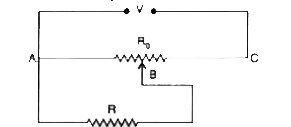An electron microscope uses electrons accelerated by a voltage of 50 kV. Determine the de-Broglie wavelength associated with the electrons. Taking other factors, such as numerical aperture etc. to be same, how does the resolving power of an electron microscope compare with that of an optical microscope which uses yellow light?Solution in Kannada
or Å
The resolving power of an electron microscope is much better than that of optical microscope.
Topper's Solved these Questions
- BOOK - OSWAAL PUBLICATIONCHAPTER - DUAL NATURE OF RADIATION AND MATTEREXERCISE - TOPIC-2 DE-BROGLIE RELATION (SHORT ANSWER TYPE QUESTIONS-II)2videos
DUAL NATURE OF RADIATION AND MATTER
- BOOK - OSWAAL PUBLICATIONCHAPTER - DUAL NATURE OF RADIATION AND MATTEREXERCISE - TOPIC-2 DE-BROGLIE RELATION (LONG ANSWER TYPE QUESTIONS)1videos
DUAL NATURE OF RADIATION AND MATTER
- BOOK - OSWAAL PUBLICATIONCHAPTER - DUAL NATURE OF RADIATION AND MATTEREXERCISE - TOPIC-2 DE-BROGLIE RELATION (VERY SHORT ANSWER TYPE QUESTIONS)8videos
DUAL NATURE OF RADIATION AND MATTER
- BOOK - OSWAAL PUBLICATIONCHAPTER - CURRENT ELECTRICITY EXERCISE - TOPIC-3 (POTENTIOMETER & APPLICATIONS) (NUMERICAL PROBLEMS)2videos
CURRENT ELECTRICITY
- BOOK - OSWAAL PUBLICATIONCHAPTER - ELECTRIC CHARGES & FIELDSEXERCISE - (TOPIC -2)Numerical Problems5videos
ELECTRIC CHARGES & FIELDS
Similar Questions
An electron and a photon each have a wavelength of 1.00 nm. Find (i) their momentum (ii) the energy of the photon and (iii) K.E of electron
05:36View SolutionWhat are matter waves? Derive an expression for the de Broglie wave length.
06:57View SolutionA proton and an electron have same kinetic energy. Which one has smaller de-Broglie wavelength ?
09:21View SolutionA resistance of RΩ draws current from a potentiometer. The potentiometer has a total resistance R0Ω.A voltage V is supplied to the potentiometer. Derive an expression for the voltage across R when the sliding contact is in the middle of the potentiometer.
 08:07View Solution
08:07View SolutionAn atom was earlier assumed to be sphere of radius a having a positively charged point nucleus of charge +Ze at its centre . This nucleus was believed to be surrounded by a uniform desity of negative charge that made the atom neutral as a whole.
Use this theorem to find the electric field of this atom at a distance r(r>a) from the centre of the atom.05:51View SolutionAn electron microscope uses electrons accelerated by a voltage of 50kV . Determine the De Broglie wavelength associated with the electrons. If other factors ( such as numerical aperture, etc.) are taken to be roughly the same, how does the resolving power of an electron microscope compare with that of an optical microscope which uses yellow light?
05:50View Solutionएक इलेक्ट्रॉन सूक्ष्मदर्शी में 50kV वोल्टता के द्वारा त्वरित इलेक्ट्रॉनों का उपयोग किया जाता है । इन इलेक्ट्रॉनों से जुड़े डी ब्रॉग्ली तरंगदैर्घ्य ज्ञात कीजिए। यदि अन्य बातों (जैसे कि संख्यात्मक द्वारक, आदि) को लगभग समान लिया जाए, इलेक्ट्रॉन सूक्ष्मदर्शी की विभेदन क्षमता की तुलना पीले प्रकाश का प्रयोग करने वाले प्रकाश सूक्ष्मदर्शी से किस प्रकार होती है?
05:50View Solutionएक इलेक्ट्रॉन सूक्ष्मदर्शी में 50 kV वोल्टता के द्वारा त्वरित इलेक्ट्रॉनों का उपयोग किया जाता है । इन इलेक्ट्रॉनों से जुड़े दी-ब्रोगली तरंगदैर्घ्य ज्ञात कीजिए । यदि अन्य बातों ( जैसे कि संख्यात्मक द्वारक , आदि ) को लगभग समान लिया जाए, तो इलेक्ट्रॉन सूक्ष्मदर्शी की विभेदन क्षमता की तुलना पीले प्रकाश का प्रयोग करने वाले प्रकाश सूक्ष्मदर्शी से किस प्रकार होती है ?
04:21View Solutionएक एलेक्ट्रॉन सूक्ष्मदर्शी में 50k V वोल्टता द्वारा त्वरित एलेक्ट्रॉनों का उपयोग किता जाता है इन एलेक्ट्रॉनों से संबध्द द ब्रॉग्ली तरंगदैर्ध्य ज्ञात कीजिए । यदि अन्य बातों ( जैसे कि संख्यात्मक द्वारक , आदि ) को लगभग समान लिया जाए , एलेक्ट्रॉन सूक्ष्मदर्शी की विभेदन -क्षमता (resolving power ) की तुलना पीले प्रकाश का प्रयोग करनेवाले प्रकाश सूक्ष्मदर्शी से किस प्रकार होती है ?
03:31View SolutionAn electron microscope uses electrons, accelerated by a voltage of 50kV. Determine the de Broglie wavelength associated with the electrons. Taking other facters, such as numerical aperature etc. to same, how does the resolving power of an electron microscope compare with that of an optical microscope which uses yellow light.
03:53View SolutionAn electron microscope uses electrons accelerated by a voltage of 50 kV. Determine the de Broglie wavelength associated with the electrons. If other factors ( such as numerical aperture, etc. ) are taken roughly to be the same, how does the resolving power of an electron microscope compare with that of an optical microscope which uses yellow light (λy=5.9×10−7m).
03:25View SolutionAn electron microscope uses electrons accelerated by a voltage of 50 kV. Determine the de Broglie wavelength associated with the electrons. If other factors ( such as numerical aperture, etc. ) are taken roughly to be the same, how does the resolving power of an electron microscope compare with that of an optical microscope which uses yellow light (λy=5.9×10−7m).
View Solutionএকটি ইলেক্ট্রন অণুবীক্ষণ যন্ত্রে ইলেক্ট্রনগুলিকে 25 KV বিভবে ত্বরান্বিত করা হল। বিভব বাড়িয়ে 100 KV করা হলে ইলেক্ট্রনগুলির সঙ্গে জড়িত ডি ব্রগলির তরঙ্গদৈর্ঘ্য
05:08View SolutionAn electron microscope uses electrons accelerated by a voltage of 50 kV. Determine the de Broglie wavelength associated with the electrons. If other factors (such as numerical aperture, etc.) are taken to be roughly the same, how does the resolving power of an electron microscope compare with that of an optical microscope which uses yellow light?
06:53View SolutionAn electron microscope uses electrons accelerated by a voltage of 50 kV. Determine the de Broglie wavelength associated with the electrons. If other factors (such as numerical aperture, etc.) are taken to be roughly the same, how does the resolving power of an electron microscope compare with that of an optical microscope which uses yellow light?
05:08View Solution

